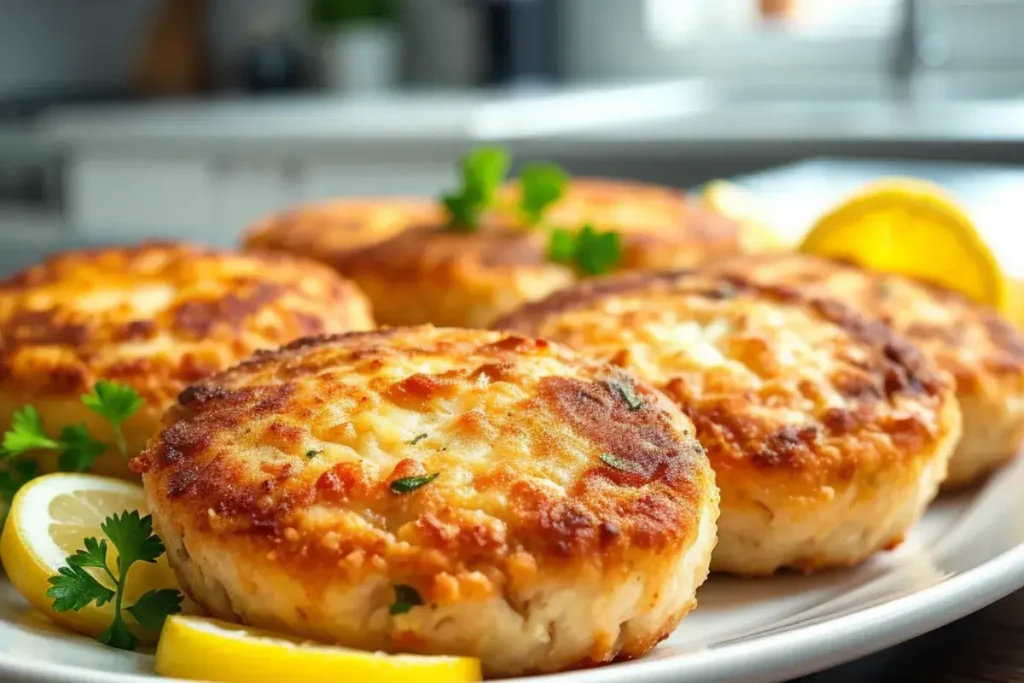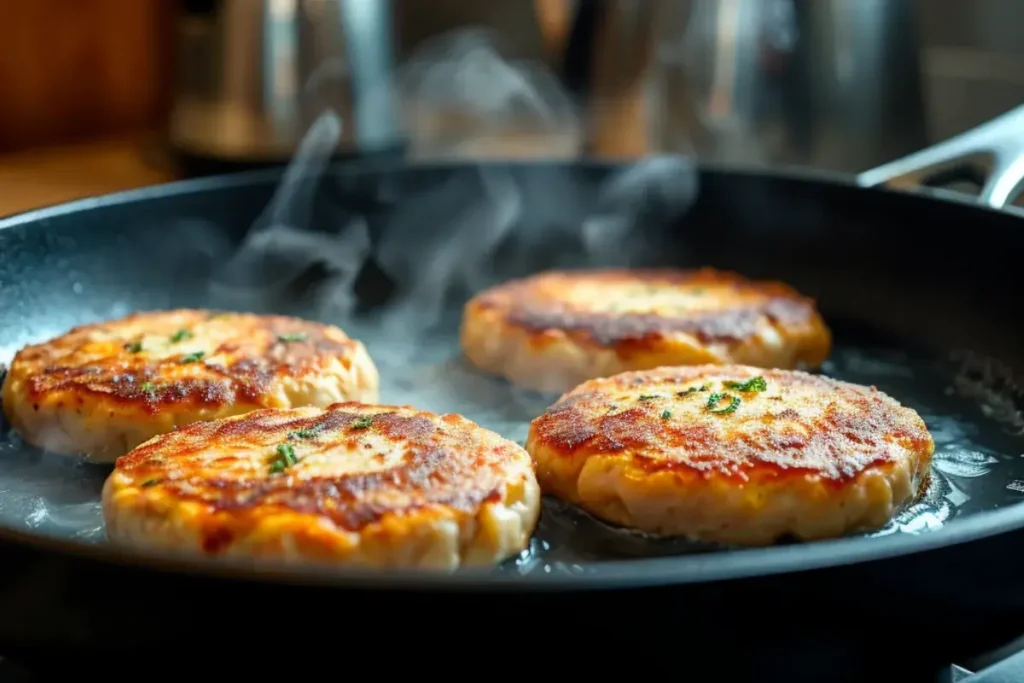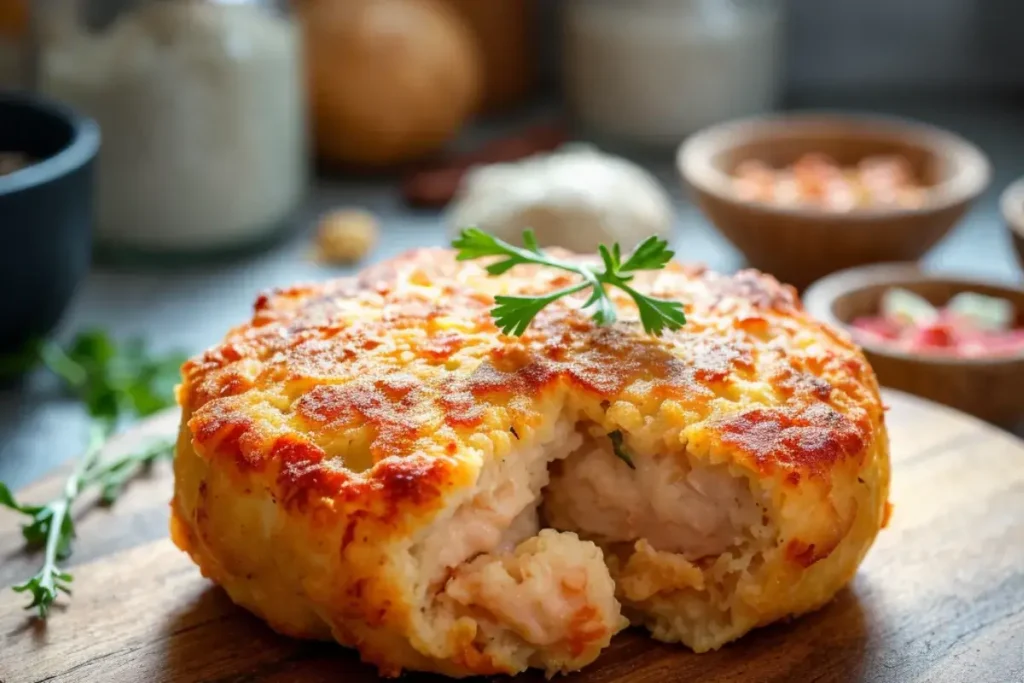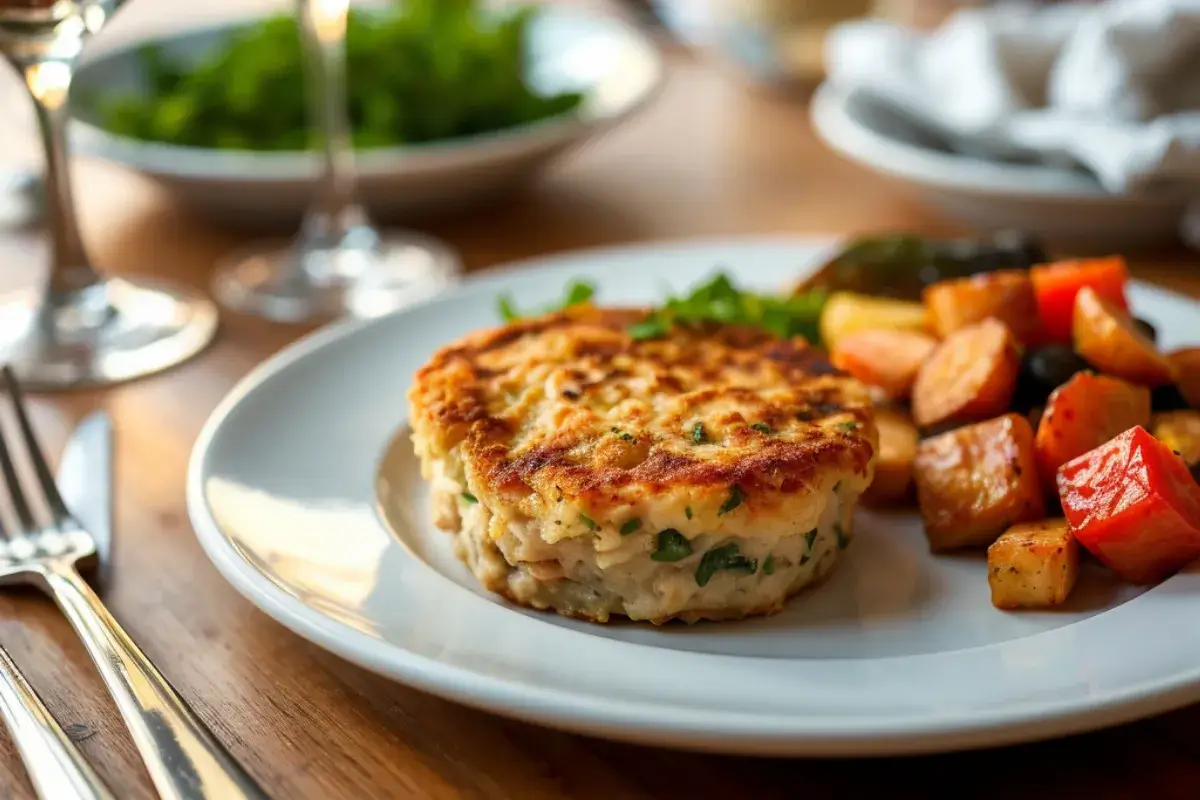Salmon patties are a delicious, healthy meal option, but many home cooks face a common problem: how to keep salmon patties from falling apart. If you’ve ever wondered why your salmon patties break apart and how to prevent it, you’re in the right place. This guide will walk you through understanding the cause of this issue, how to choose the right ingredients, and proper techniques to keep your salmon patties firm and intact.
How to Keep Salmon Patties from Falling Apart: Understanding the Problem
So, why do salmon patties fall apart? The main culprit is typically a lack of proper binding ingredients or excessive moisture in the mixture. Salmon, whether fresh or canned, contains a high amount of natural moisture. This moisture needs to be controlled, or your patties will be too soft to hold their shape. Furthermore, using the wrong proportions of ingredients can lead to an uneven texture, making the patties fragile.
Common mistakes people make include:
- Not using enough binder (like eggs or breadcrumbs)
- Overloading the patties with vegetables or other fillings
- Failing to chill the mixture before cooking
By understanding these potential pitfalls, you can take the necessary steps to avoid them and create firm, delicious salmon patties.
Choosing the Right Ingredients to Prevent Salmon Patties from Falling Apart
Choosing the right ingredients is crucial to achieving a salmon patty that holds together perfectly. Each ingredient plays a specific role in maintaining the structure of the patty, and balancing these components is key.
Fresh vs. Canned Salmon: Which Is Better?
Both fresh and canned salmon can be used for salmon patties, but understanding their moisture levels is key in how to keep salmon patties from falling apart. Fresh salmon typically contains more moisture, which can make the patties harder to keep together. Canned salmon, on the other hand, has less moisture and often works better in terms of structure. If you’re looking for a great recipe using either type of salmon, check out this detailed Salmon Cakes Recipe.
Pro tip: If using fresh salmon, make sure to drain the excess liquid thoroughly before mixing it with your other ingredients. If you’re opting for canned salmon, you’ll still want to remove any extra liquid. Too much moisture can make your mixture soggy and unstable.
The Role of Binders: Eggs, Breadcrumbs, and More
The binder is arguably the most important ingredient when it comes to keeping your patties from falling apart. Eggs are commonly used as a binder because they help hold all the ingredients together. The proteins in eggs firm up when cooked, giving the patties their structure.
In addition to eggs, breadcrumbs are another essential binder. Breadcrumbs absorb excess moisture and add body to the mixture. You can also experiment with alternatives like panko or almond flour for different textures. The key is to strike a balance—too much binder, and your patties will be dry; too little, and they’ll fall apart.
If you’re looking for a binder alternative, especially for gluten-free or paleo options, there are numerous possibilities, including using flaxseed meal as an egg substitute or trying out gluten-free breadcrumbs.
Adding Vegetables: A Balancing Act
Vegetables are a great way to add flavor and nutrition to your salmon patties, but they can also contribute unwanted moisture. Popular add-ins like onions, peppers, and even spinach can release water as they cook, which might make your patties fall apart.
Tips for adding vegetables:
- Chop vegetables finely to reduce the risk of chunks creating weak spots in the patties.
- Pre-cook vegetables like spinach or onions to reduce their moisture content before adding them to your mixture.
By balancing your veggie content, you can ensure that your salmon patties stay flavorful without becoming unstable.
Proper Techniques to Keep Salmon Patties Together
Once you’ve selected the right ingredients, it’s time to focus on proper techniques. Even the best ingredients won’t hold up if the preparation isn’t done right. These techniques are key to creating firm, stable salmon patties.

Drain Excess Moisture from the Salmon
Whether you’re using fresh or canned salmon, draining off excess moisture is critical. Too much liquid will make the mixture too soft, making it difficult for the binder to work. Use paper towels or a fine mesh strainer to squeeze out the extra liquid from the salmon.
If you’re using fresh salmon, you can also bake or pan-sear it lightly before mixing it with your ingredients. This step helps remove moisture and gives the patties a firmer texture. Harvard School of Public Health’s Guide to Omega-3 also offers useful insights into how fresh salmon contributes to both health and cooking outcomes.
Mix the Ingredients Thoroughly
Another common issue is uneven distribution of ingredients. When mixing your salmon patty mixture, be sure to combine everything thoroughly, so the binders are evenly dispersed. This ensures that the patties hold their shape while cooking.
Be careful, however, not to overmix. Overworking the mixture can break down the salmon and create a mushy texture, which will make it harder to form sturdy patties.
Chill the Mixture Before Cooking
This is a step that many people overlook. After forming your patties, let them chill in the refrigerator for at least 30 minutes before cooking. Chilling the mixture is one of the most important steps in how to keep salmon patties from falling apart, as it allows the ingredients to bond properly.
Why this works: Chilling allows the binders to solidify slightly, so when they hit the hot pan, they hold together better. This step can mean the difference between perfect patties and crumbly chaos.
Cooking Techniques for Sturdy Salmon Patties
Mastering the cooking process is essential in how to keep salmon patties from falling apart and ensuring they come out perfectly. Even if you’ve prepared the mixture perfectly, improper cooking techniques can still cause them to crumble.

Using the Right Pan and Oil
The type of pan and oil you use plays a significant role in keeping the patties intact during cooking. Non-stick pans and cast iron skillets are your best options. Non-stick pans make it easier to flip the patties without them sticking, while cast iron helps achieve that golden, crispy exterior.
As for the oil, opt for one with a high smoke point like avocado oil, grapeseed oil, or canola oil. These oils can withstand higher temperatures without burning, allowing you to cook your patties evenly without risking a messy disaster. Healthline’s Guide to High Smoke Point Oils offers some great options to consider for this step.
Avoiding Overcrowding in the Pan
One common mistake is overcrowding the pan. If you place too many patties in the pan at once, they won’t cook evenly, and the steam produced will prevent the patties from developing a crispy crust. This steam also makes it harder for the patties to firm up, increasing the chances of them falling apart.
Pro tip: Cook the patties in batches, giving them plenty of space to breathe. This not only helps them cook evenly but also allows you to flip them without disrupting their shape.
Flipping at the Right Time
Flipping the patties too soon can be disastrous. The outside needs to have enough time to form a crust before flipping, which helps hold everything together. Wait until the edges of the patties turn golden brown before gently flipping them with a wide spatula.
Tips for flipping:
- Use a wide spatula to support the entire patty.
- Flip only once during cooking to minimize handling.
Best Alternatives to Traditional Salmon Patty Binders
If you’re looking for alternatives to the usual binders like eggs and breadcrumbs—whether for dietary reasons or just for a twist on the recipe—there are plenty of options to consider.
Gluten-Free Binders
For those following a gluten-free diet, you can substitute regular breadcrumbs with gluten-free varieties or use almond flour. Oat flour is another great option because it adds structure without making the patties too dense. You can also try mashed potatoes or quinoa as binders, both of which are gluten-free and add a unique texture to your patties.
Egg-Free Options for Vegan or Allergy-Friendly Patties
If you’re avoiding eggs due to allergies or dietary preferences, you can use flaxseed meal or chia seeds as a binding alternative. Both work by absorbing moisture and firming up as they sit, creating a texture similar to eggs. To make a flax or chia egg, simply mix 1 tablespoon of flaxseed meal or chia seeds with 3 tablespoons of water, and let it sit for about 10 minutes until it thickens.
Dairy-Free Binders
Many traditional salmon patty recipes call for milk or cheese as part of the binder. For those avoiding dairy, there are simple substitutions that won’t affect the structure. Use dairy-free alternatives like almond milk or oat milk. These options will give you the same moisture without compromising the binding process.
Flavor Enhancements Without Compromising Structure
While keeping your salmon patties intact is essential, you don’t have to sacrifice flavor. There are plenty of ways to enhance the taste while still maintaining a solid patty.

Herbs and Seasonings That Complement Salmon
Fresh herbs like dill, parsley, and chives pair beautifully with salmon. These herbs add a burst of freshness without adding excess moisture. Seasonings like garlic powder, onion powder, and a dash of cayenne pepper can also elevate the flavor profile of your patties. For more ways to intensify the flavor of your salmon dishes, explore these tips for enhancing salmon flavor.
Adding Cheese: When to Use It and How to Prevent Sogginess
Cheese can add a delicious creaminess to your patties, but too much can make them soggy. If you want to incorporate cheese, opt for a firmer variety like Parmesan or feta, which won’t release as much moisture as softer cheeses. Grating the cheese finely and mixing it evenly into the patty mixture ensures that it enhances flavor without compromising the structure.
Troubleshooting Common Salmon Patty Problems
Even with the best techniques, sometimes things go wrong. Here’s how to troubleshoot some of the most common issues people encounter when making salmon patties.
What to Do If Patties Are Too Wet
If your mixture is too wet to hold together, don’t panic! You can easily fix it by:
- Adding more breadcrumbs, panko, or any binder you’re using.
- Letting the mixture sit for a few minutes to allow the binder to absorb the excess moisture.
- Gently pressing out the excess moisture before forming the patties.
What to Do If Patties Are Too Dry
If the mixture is too dry, your patties will be crumbly and difficult to shape. To remedy this, you can:
- Add a small amount of moisture, like a little extra egg or even a tablespoon of mayo.
- Mix in some olive oil for extra richness and moisture.
Salvaging Patties That Are Falling Apart While Cooking
If your patties are falling apart mid-cooking, lower the heat and try to reshape them gently. Sometimes, lowering the heat allows the patties to cook more slowly, giving them time to firm up before flipping.
How to Store and Reheat Salmon Patties Without Breaking
Once you’ve mastered your salmon patty recipe, you’ll likely want to make a batch ahead of time. But how do you store and reheat them without them falling apart?
Proper Storage Techniques
Store cooked patties in an airtight container in the fridge for up to 3 days. If you’re prepping for future meals, you can also freeze the uncooked patties. Lay them on a baking sheet to freeze individually before transferring them to a freezer bag. This way, they won’t stick together.
Best Reheating Methods
When reheating salmon patties, avoid the microwave as it can make them soggy. Instead, reheat them in a skillet over medium heat for a few minutes on each side. You can also reheat them in the oven at 350°F for about 10 minutes to retain their crispiness.
Freezing for Future Use
To freeze salmon patties for future use, first, shape the uncooked mixture into patties and lay them flat on a parchment-lined baking sheet. Freeze them until firm, then transfer them to a freezer-safe container or bag. This method prevents them from sticking together, and they can be cooked directly from frozen without thawing.
Tips for Making Healthier Salmon Patties That Stay Together
Salmon patties are already a healthy meal, but there are ways to make them even more nutritious without compromising their structure.
Using Fresh, Whole Ingredients
The fresher your ingredients, the better your patties will taste and hold together. Fresh vegetables, salmon, and herbs can make a huge difference in both flavor and texture. Opt for fresh salmon instead of canned if possible, and always choose high-quality, nutrient-rich binders like quinoa or almond flour.
Baking vs. Frying: Healthier Cooking Methods
For a healthier option, try baking your salmon patties instead of frying them. Baking them at 375°F for about 20 minutes (flipping halfway) can yield crispy patties without the added fat from frying.
Using Nutrient-Dense Binders
Instead of breadcrumbs, try using healthier alternatives like oat flour, quinoa, or even mashed sweet potatoes as binders. These options not only help keep your patties together but also add a boost of nutrition to the meal.
Frequently Asked Questions (FAQs)
Why do my salmon patties fall apart when I cook them?
Salmon patties usually fall apart due to too much moisture in the mixture or not enough binder. To prevent this, ensure you drain excess liquid from the salmon and use enough binder like eggs or breadcrumbs.
Can I make salmon patties without eggs?
Yes, you can substitute eggs with options like flaxseed meal or chia seeds mixed with water. These alternatives act as binders in egg-free recipes.
How do you know when salmon patties are cooked through?
Salmon patties are cooked through when they are golden brown on the outside and firm to the touch. This usually takes 4-5 minutes per side when frying over medium heat.
Can I use a grill instead of a pan to cook salmon patties?
Yes, you can grill salmon patties, but it’s essential to make sure the mixture is firm and the patties are chilled before grilling to prevent them from falling apart.
How do I make gluten-free salmon patties that hold together?
For gluten-free salmon patties, use gluten-free breadcrumbs, almond flour, or even mashed potatoes as a binder. Just ensure the mixture is well-combined and firm before cooking.
By following these techniques, tips, and troubleshooting methods, you’ll understand exactly how to keep salmon patties from falling apart and make delicious, sturdy patties every time. Whether you’re going for the classic recipe or experimenting with healthier alternatives, the key is to balance moisture and binders while using proper cooking techniques. Enjoy your perfectly cooked salmon patties!

